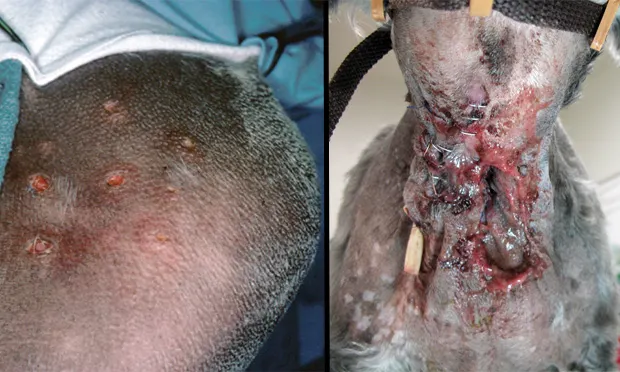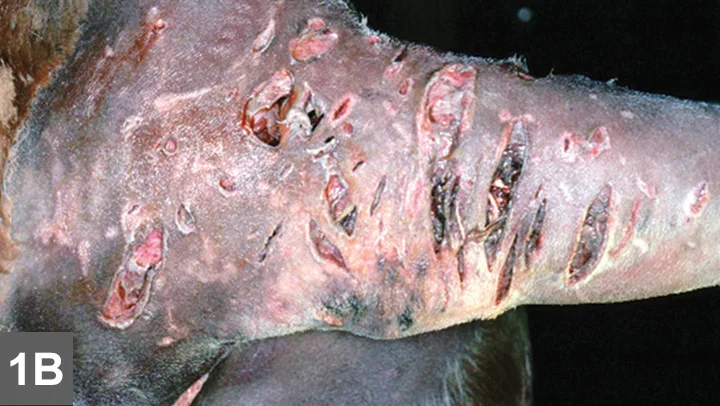Bite Wounds
Bonnie Grambow Campbell, DVM, PhD, DACVS, Washington State University

This is a two-article feature: The Consultant on Call provides an overview of bite wounds, while its companion article, Surgical Treatment for Bite Wounds, presents a step-by-step treatment plan.
Profile
Pathophysiology
When an attacker shakes its head while biting, the victim’s elastic skin moves with the attacker’s teeth, often leaving only puncture wounds in the skin.
However, the teeth can also tear through fixed deeper tissue, creating dead space and inoculating the wound with bacteria and foreign material.
The teeth can exert ≤450 psi, furthercompromising vasculature and tissue.
Victims that initially appear stable may present days later with systemic inflammatory response syndrome (SIRS) or sepsis (SIRS + infection) when local inflammatory, immunologic, coagulatory, and fibrinolytic cascading may overwhelm the patient’s defenses.1
Iceberg effect describes minimal surface damage belying expansive damage underneath (Figure 1).

This adult mastiff was attacked by another mastiff. At initial presentation (A), the only evidence of injury involved multiple small puncture wounds around the elbow of the right thoracic limb (medial side of elbow shown), which were clipped and cleaned but not explored. Several days later (B), the dog re-presented with severe necrosis in the bitten leg (lateral side of right forelimb shown). The patient became septic and died.

Physical Examination
Life-threatening injuries (eg, tracheal laceration, penetration into the thoracic cavity, major hemorrhage) should be addressed immediately, including therapeutic use of oxygen, fluids, blood products, vasopressors, thoracentesis, intubation, pressure wraps, and topical hemostatic agents as appropriate.
Wounds should be covered with sterile dressings until the patient is stabilized.
Thorough examination requires extensive shaving to reveal hidden wounds (especially under thick hair coat).
Bruising often indicates crush injury.
The patient should be examined for neurologic deficits, joint instability, and body cavity damage.
Bite wounds can cause spinal injury, rupture ligaments, and/or cause deep vital organ and body wall damage.
Sedation or anesthesia is often needed for complete wound assessment.
Probing puncture wounds with a sterile instrument may indicate depth or amount of dead space.
Because wounds may not be straight (a result of shaking), damage may be deeper than can be probed.
Probing should not be the sole technique when determining whether the abdominal or thoracic wall has been breached.
Documentation with photographs and measurements can help monitor healing and can be beneficial to clients if legal action is pursued against the attacker’s owner.
Local police and authorities should be consulted when handling evidence (eg, attacker’s tooth) retrieved from the patient.
Diagnosis
Laboratory Testing
Laboratory tests should include CBC, chemistry panel, and urinalysis for patients in shock or requiring anesthesia.
These help determine the best treatment (eg, direct choices for fluids, blood products, drugs).
Coagulation testing is beneficial if the patient is considered at risk for disseminated intravascular coagulation.
Imaging
Radiography can identify fractures, dislocations, SC emphysema, foreign material, free fluid or air in the chest or abdomen, or body wall or diaphragmatic disruption ± herniation.
Absence of radiographic abnormalities does not rule out internal injuries.
Ultrasonography, CT, and MRI can provide additional diagnostic details.
Other Diagnostics
Thoracentesis & Abdominocentesis
Thoracentesis can be therapeutic in a dyspneic patient.
Fluid can be characterized on cytologic examination.
Negative taps do not rule out internal injury.
Ultrasound-guided needle aspiration can be performed if initial abdomino-centesis is negative.
Needle aspiration of the abdominal cavity may introduce some free air, causing false alarm.
Emergency surgical exploration of the abdomen is recommended if serious organ damage is suspected, evidence of abdominal wall penetration is found (eg, free air within the abdominal cavity), or wounds over the abdominal region are present and abdominal wall penetration cannot be ruled out.
Cervical Bite Wound Assessment
Endoscopy of the esophagus and trachea is advised to allow early treatment (Figure 2).
Tracheal injury can be suspected if pneumomediastinum and/or marked SC emphysema are found; esophageal tears may not be clinically apparent for several days.
Laryngeal function should be assessed with patient under a light plane of anesthesia.1

Figure 2. View of the ventral neck in a standing schnauzer referred for treatment of 4-day-old cervical bite wounds. Severe laryngeal and tracheal trauma and esophageal perforation were diagnosed by endoscopy.
Postmortem Findings
If the patient dies and the client is considering legal action against the attacker’s owner, necropsy by a board-certified pathologist is advised.
Treatment
Inpatient or Outpatient
Hospitalization depends on injury severity.
Close, daily monitoring is required (even for outpatients), as necrosis, infection, and/or internal injuries may not become apparent for days.
Educating clients about the iceberg effect is important:
Education can emphasize the importance of exploring bite wounds and prepares clients for potential internal injuries.
It can also emphasize the need to monitor outpatients for signs of infection and the importance of follow-up appointments.
Surgical
Bite wounds should be opened, explored, debrided, and lavaged for 2 reasons:
Diagnostic testing does not fully reveal the extent of damage.
Removal of devitalized tissue is necessary to prevent or treat SIRS or sepsis.
If there is no damage underneath the skin, surgery is minor.
If the damage penetrates deeper tissue, surgery may be life-saving.
For fresh wounds, a 12–24-hour delay in surgery allows patient stabilization and for tissues to declare as being viable or nonviable.
Surgery should not be delayed if SIRS or sepsis resolution requires debridement, abdominal penetration has not been ruled out, orsurvival depends on immediate surgery (eg, extensive tracheal laceration or transection, hemorrhage that requires surgical ligation).
For step-by-step details on Surgical Treatment for Bite Wounds, see the companion article.
Medications
Drugs & Fluids
Fluids, blood products, analgesics, vasopressors, and other treatments should be administered per patient status.
NSAIDs should be avoided until the patient is rehydrated and appears free of GI, hepatic, or renal compromise.
Antibiotics
Pre- & Intraoperative
Antibiotics do not replace the need for debridement and lavage.
Empiric IV antibiotics should be started immediately in patients with abdominal perforation, extensive tissue damage, SIRS, immunocompromise, and/or infected wounds.
In stable patients with infected wounds, antibiotic administration may be postponed until an intraoperative culture is obtained.
During surgical debridement, time-dependent antibiotics should be given q90min IV to all bite wound patients.
Empiric use of ampicillin, amoxicillin, cephalexin, or potentiated sulfonamide is recommended for less severe wounds.
Fluoroquinolone or aminoglycosides should not be administered alone, as they do not kill anaerobes (common in devitalized tissue).
Aminoglycosides should not be used in patients with poor perfusion (eg, shock, sepsis) or renal compromise because of risk for nephrotoxicity.
Stronger choices (eg, amoxicillin–clavulanate, ceftiofur, combinations such as cefazolin + [fluoroquinolone or aminoglycoside] + [ampicillin or metronidazole]) should be reserved for patients with severe wounds and/or systemic compromise.
Postoperative
If a wound is infected, IV antibiotics should be continued, eventually switching to oral administration when infection is controlled and risk for systemic spread is minimal.
Antibiotics can be adjusted as per the results of aerobic and anaerobic cultures, preferably from a tissue sample (not a swab) deep in the wound.
For uninfected wounds:
Postoperative antibiotics are not indicated in immunocompetent patients with fresh, shallow, noncrushed, uninfected wounds in which only clean, healthy tissue clearly remains after thorough debridement and lavage (a small percentage of patients).
Postoperative antibiotics are indicated in patients with uninfected wounds and extensive tissue damage, SIRS, and/or immunocompromise.
Risk for infection can increase according to the amount of contamination and tissue compromise.
Patients should be reassessed regularly to avoid unnecessary antibiotic use if the wound is healing appropriately.
Follow-up
AVMA and governmental guidelines can provide information on bite wounds involving animals unvaccinated for rabies.
Cats should be tested for FeLV or FIV ~60 days after being bitten by a cat.
In General
Relative cost (see Cost Key) and prognosis reflect severity of injury: $$ to $$$$$
Dr. Campbell is a consultant for KCI Animal Health with a special clinical interest in negative pressure wound therapy.